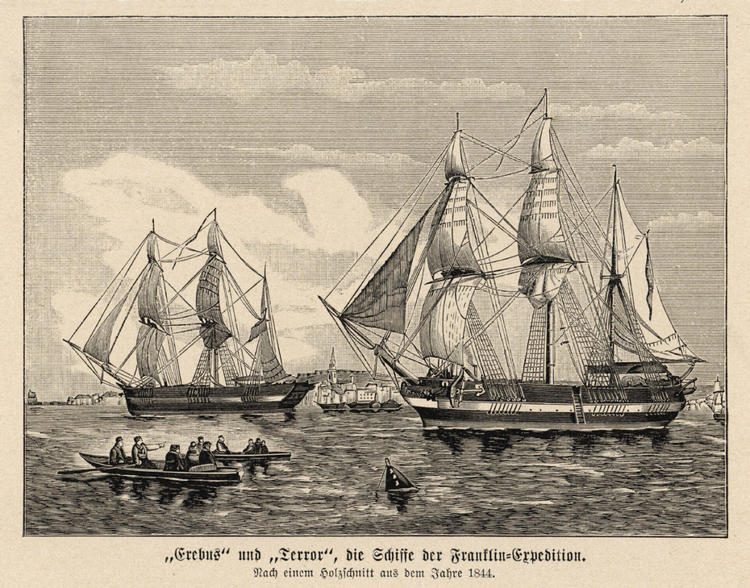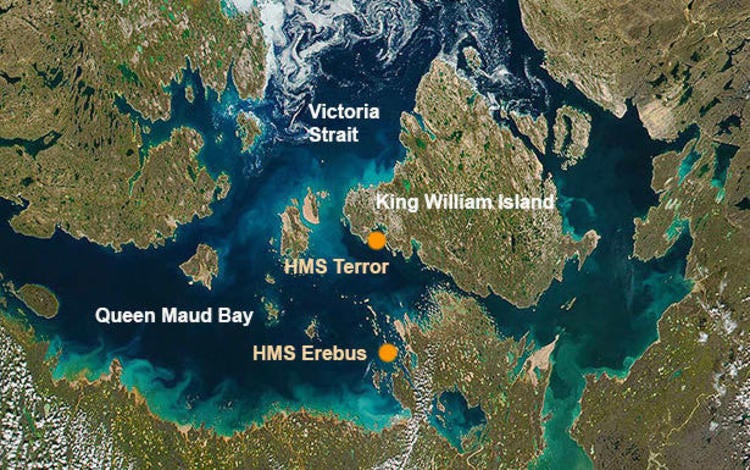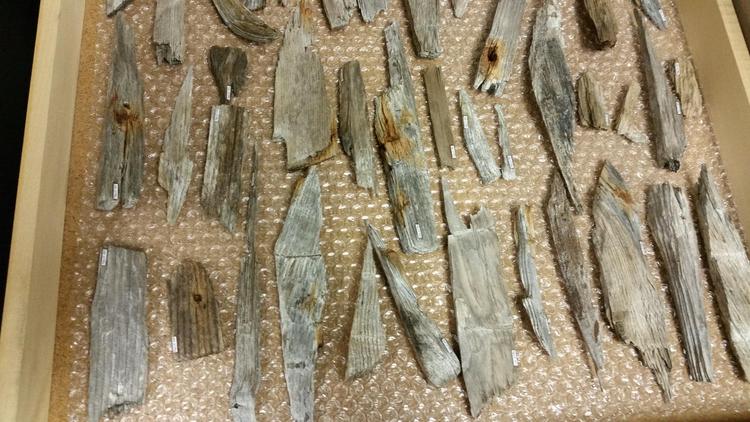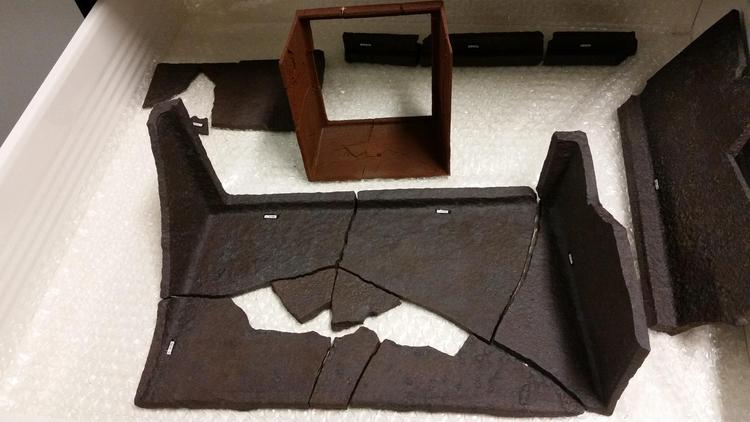What Happened?
In 1845, British explorer Sir. John Franklin departed from England for Northern Canada with 129 crewmembers on the HMS Erebus and HMS Terror in search of the Northwest Passage. They were never seen again. The Franklin Expedition has been shrouded in mystery for a long time, and it is only in 2014 and 2016 respectively that the HMS Erebus and HMS Terror were discovered. What exactly happened back then?

Picture 1: 1844 Drawing of the HMS Erebus and Terror from the Franklin-Expedition
The Mystery Explained
While they were sailing in the freezing waters, the ships were caught in a natural flux in the climate now referred to as the Little Ice Age, a period over 600 years in which the climate was naturally cooling down. The effects of it on the arctic waters off the northern coast of Canada was that both ships became stuck in ice as the water froze solid in September of 1846 [1]. Unable to move, the crew was forced to wait for the ice to melt in order to continue their expedition or turn around; neither was possible. They waited for the summer, hoping that the ice would thaw, but to no avail. Finally, 19 months after being frozen in the ice, the surviving crew of 105 men decided to abandon the ships and try to make it to the Back River, which runs into the Northwest Territories, in the hopes of sailing down it to a fur trading post. They dragged boats and supplies on foot across kilometers of ice, but sadly all them died on this ambitious trek. The failure to reach the river was perhaps helped along by the fact that, while the ships had carried enough canned food for three years, the cans were cheaply produced with lead soldering, which, as was confirmed by autopsy reports, leached into the food, and likely further debilitated the crew on their journey. The sites of these survivors were vital links to the lost ships, and were of great research interest to anthropologist and archaeologist Robert Park into how the Inuit people were affected by the presence of these crew members in the north. [1]
Robert Park's Interest and Role in the Discovery of the HMS Erebus
Robert Park has been an anthropology professor at the University of Waterloo since 1994, and is serving as the Associate Dean of Arts for Infrastructure and Technology. His research focuses on the cultures of the Far North, particularly on the Inuit people, and he spends a lot of time in northern Canada for his research and archaeology fieldwork. Robert’s interest in the cultures of the Far North is rooted in the uniqueness of these small groups in how they both physically, and culturally, have survived in these cold hostile landscapes for centuries. The discovery of the Franklin Expedition, and the sites of the crew that tried to flee the doomed ships, serves as another window into these unique communities.
Since 2008, Robert had been helping the Government of Nunavut with the Franklin Expedition by looking at the sites of these survivors. His interest in these sites is in how the introduction of the materials found in the sites of the crew members who fled the ships would have affected the lives of the Inuit who came across them. Materials such as metal, which the survivors had an abundance of, were rare for the nomadic Inuit people, and would have been extraordinarily useful. Of interest was also what could be gleaned from these sites about the escape attempt and if the sites could point to the locations of the two ships. Following their disappearance, both the British and the Americans sent numerous expeditions into the north to find them between 1848 and 1854 but while mapping most of northern Canada in the process, all returned empty handed.
There had been a concerted effort involving teams of water archaeologists since 2008 to find the ships, but by 2014, nothing had been found yet. There was a vague estimation of the location of the ships based on interviews of Inuit people over a century ago, and the estimations of the crew that attempted to reach the Back River, but this estimation encompassed an area approximately the size of the entire KW-area, most of which was made up of water. The survival sites were also not good ways of narrowing down this area. How far the survivors managed to travel was unsure, and the nomadic Inuit people that came across the remains of these survivor sites likely spread the materials as well. In 2014, there was a breakthrough when the Government of Nunavut team discovered a portion of the ship on a small island in Nunavut. Upon alerting the underwater archaeologists, they moved their search to that area and immediately found the wreck of the HMS Erebus south of King William Island [3].

Picture 2: The locations where the two ships were finally discovered
Re-creating Artifacts with 3-D Printing
Among many of the crew member sites on land, the actual site of the wreck itself, and in Inuit communities, parts of the ships have been recovered (Picture 3 and 4). Robert and his team have made use of 3-D printing to reconstruct fragmentary artifacts to try and better determine what they would have looked like fully assembled and how they were then modified. How these items, particularly the metal items, were modified, allows many insights into the Inuit community. Advancing technologies like 3-D printing are exceedingly helpful in the field of archaeology. For example, as can be seen in picture 4, the 3-D form of the artifact (back, printed at 40% scale of the original) allows archaeologists to better visualize the original artifact (front). The sites themselves have recently been endangered by the influx of tourism to the area because of the finds, and the government has had to step in and collect items on or close to the surface to preserve them for future research. For now, there is still a lot of work to be done and Robert is excited to focus on the artifacts recovered from the sites up to this point.

Picture 3: Remnants of the ships

Picture 4: A recovered iron stove from one of the ships. Original (front) and 3-D print (back)
The Significance of the Finding
The find of the HMS Erebus, and even more so the on-land sites, are of great significance for the academic community as well as for the history of Canada. The second ship, the HMS Terror was found further north in Terror Bay in 2016 [3] and more and more details about the lost expedition are being uncovered. Many Canadians grew up learning about the lost Franklin Expedition, and the recovery of the ships after years of searching for them ends the mystery surrounding the whole affair. As the then Prime Minister Harper put it:
This is truly a historic moment for Canada. Franklin’s ships are an important part of Canadian history given that his expeditions, which took place nearly 200 years ago, laid the foundations of Canada’s Arctic sovereignty [2].
References
[1] Stenton, D.R., Keenleyside, A., Trepkov, D.P., & Park, R.W. (2016). Faces from the Franklin expedition? Craniofacial reconstructions of two members of the 1845 northwest passage expedition. Polar Record, 52(1), 76-81. Doi: 10.1017/S0032247415000248.
[2] Franklin ship discovery: Stephen Harper’s full statement. CBC News (2014, September 9). http://www.cbc.ca/news/politics/franklin-ship-discovery-stephen-harper-s-full-statement-1.2760566
[3] Parks Canada, Government of Canada. (Updated July 2017). The Franklin Expedition. Retrieved from https://www.pc.gc.ca/en/culture/franklin
[4] [HMS Erebus and HMS Terror]. (n.d.). Retrieved from https://www.thestar.com/content/dam/thestar/news/canada/2014/09/09/franklin_expedition_hms_terror_bombing_vessel_took_war_of_1812_by_storm/ships_in_1845.jpg
[5] [Location of Franklin Expedition]. (n.d.). Retrieved from http://www.20min.ch/diashow/183686/5F445FCEA44D7B4B5204D1ABD5305FEE.jpg
[6] [Franklin Expedition]. (n.d.). Retrieved from https://www-tc.pbs.org/wgbh/nova/assets/img/full-size/franklin-expedition-merl.jpg











